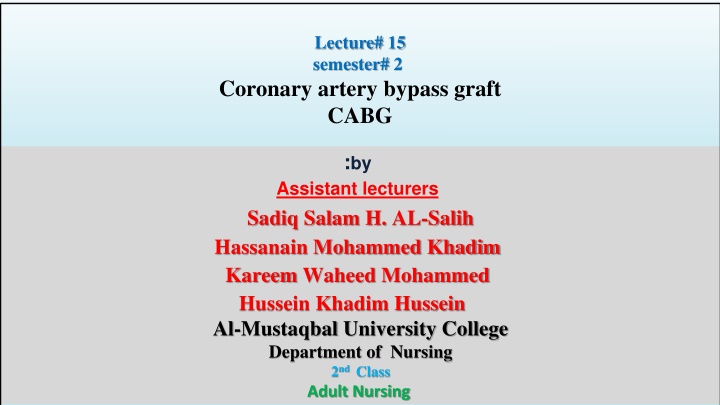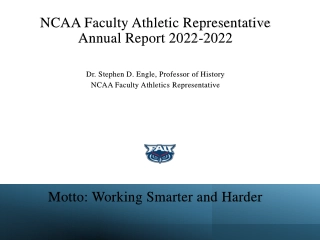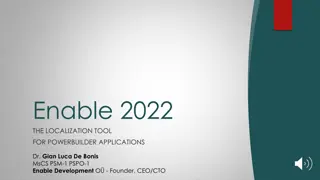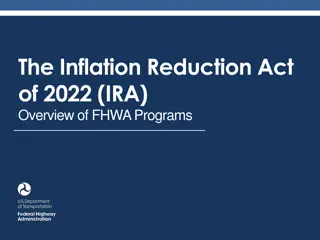
Understanding Coronary Artery Bypass Graft Surgery (CABG)
Explore the details of Coronary Artery Bypass Graft surgery (CABG) - a cardiac surgical technique using various grafts to treat heart diseases. Learn about the causes, preoperative diagnostic tests, standard procedures, and vessel patency associated with CABG. Get insights from Assistant lecturers Sadiq Salam H. AL-Salih, Hassanain Mohammed, Khadim Kareem Waheed, Mohammed Hussein Khadim Hussein from Al-Mustaqbal University College Department of Nursing.
Download Presentation

Please find below an Image/Link to download the presentation.
The content on the website is provided AS IS for your information and personal use only. It may not be sold, licensed, or shared on other websites without obtaining consent from the author. If you encounter any issues during the download, it is possible that the publisher has removed the file from their server.
You are allowed to download the files provided on this website for personal or commercial use, subject to the condition that they are used lawfully. All files are the property of their respective owners.
The content on the website is provided AS IS for your information and personal use only. It may not be sold, licensed, or shared on other websites without obtaining consent from the author.
E N D
Presentation Transcript
Lecture# 15 semester# 2 Coronary artery bypass graft CABG :by Assistant lecturers Sadiq Salam H. AL-Salih Hassanain Mohammed Khadim Kareem Waheed Mohammed Hussein Khadim Hussein Al-Mustaqbal University College Department of Nursing 2nd Class Adult Nursing
Cardiac surgery Cardiac surgery is surgery on the heart or great vessels performed by cardiac surgeons. Frequently, it is done to treat complications of ischemic heart disease (for example, coronary artery bypass grafting), correct congenital heart disease, or treat valvular heart disease
What is CABG Coronary artery bypass graft is the surgical technique which uses saphenous leg veins as grafts (SVG) or the internal mammary (LIMA or RIMA) /radial arteries as grafts to bypass obstructed portions of a coronary artery
Causes of CABG Causes of CABG Stable angina but meds not controlling pain, pt has function Non-successful PTCA with evolving MI Unstable angina A positive exercise tolerance test [treadmill], & lesions or blockage that cannot be treated by PTCA A Left Main Coronary lesion or blockage of more than 60% (50%) Single or double vessel disease with type B or C lesions
PREOPERATIVE DIAGONSTIC TEST PREOPERATIVE DIAGONSTIC TEST ECG Laboratory (CBC, BUN, ABGs, PT, PTT) Chest x ray Echocardiogram Cardiac enzyme test (troponin ) TMT
Standard Cardiac surgery Standard Cardiac surgery :Requires Requires CPB(Cardiopulmonary bypass) Aortic cross clamping cardioplegia arrest Cardiopulmonary Bypass Moves oxygenated blood around the body during open heart surgery Core body temp is lowered to 28 C to 32
CPB CPB
Vessel Patency Vessel Patency internal mammary artery graft 90% patency at 10 years . saphenous vein graft 50% patency at 10 years
Complications of CABG Complications of CABG Early Bleeding blood loss not to exceed 300cc/hr (200) in first several hours. After several hours should slow to 150-200 cc/hr.The average total loss is 1 liter Possible bleed sites leg & chest wounds cardiac tamponade- heart is compressed by blood in the mediastinal. The heart is unable to fill adequately causing low CO and Hypotension
Late Postoperative Period Late Postoperative Period Wound Infection Hepatitis Pancreatitis [early or late] Systemic arterial emboli endocarditis Dysrhythmias and MI Occlusion of graft
NURSING MANAGEMENT Preoperative Nursing Management. Intraoperative Nursing Management. Postoperative Nursing Management.
PREOPERATIVE ASSESSMENT History Physical examination Radiographic examination Electrocardiogram
PHYSICAL EXAMINATION General appearance and behavior Vital signs Nutritional and fluid status, weight and Height Inspection and palpation of heart Auscultation of heart Peripheral pulses. Peripheral edema
NURSING DIAGNOSIS Knowledge deficit regarding the surgical procedure and the postoperative course. Fear related to surgical procedure, its uncertain outcome, and the threat of well-being.
INTERVENTIONS Patient and family teaching about Hospitalization Surgery Length of surgery Expected pain and discomfort Critical care phase Recovery phase
INTERVENTIONS Physical preparation before surgery Medications before surgery Information regarding equipments, tubes that will be present postoperatively Teaching the postoperative exercises.
INTRAOPERATIVE NURSING MANAGEMENT Assisting in surgical procedure Continuous monitoring Monitoring for complications: dysrhythmias, hemorrhage, MI, embolization etc.
POST OPERATIVE NURSING MANAGEMENT ASSESSMENT: Neurological status Cardiac status Respiratory status Peripheral vascular status Renal function Fluid & electrolyte status
POST OPERATIVE ASSESSMENT Pain Assessment of equipments and tubings Psychological and emotional status as patient regains consciousness Assessing for complications.
NURSING DIAGNOSIS Decreased cardiac output related to blood loss and compromised myocardial function Risk for impaired gas exchange related to trauma of extensive chest surgery
INTEREVENTIONS Monitor cardiovascular status Assess arterial pressure every 15 min. until stable Auscultate for heart sounds and rhythms Assess all peripheral pulses Hemodynamic monitoring ECG monitoring Assess cardiac enzymes Monitor urinary output Observe for persistent bleeding Observe for cardiac tamponade Observe for signs of cardiac failure Prepare to administer diuretics, digoxin Observe for myocardial infarction.
INTERVENTIONS Maintain proper ventilation Monitor arterial blood gases, tidal volumes, peek inspiratory Auscultate chest for breath sounds Provide chest physiotherapy as prescribed Promote deep breathing coughing and turning, use of incentive spirometer. Teach incisional splinting with a cough pillow to decrease discomfort during deep breathing and coughing Suction tracheobronchial secretions as needed, using aseptic technique
THANK YOU THANK YOU






















